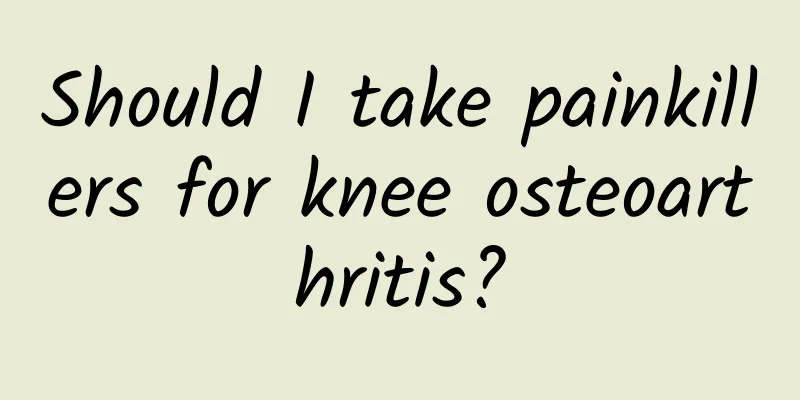Should I take painkillers for knee osteoarthritis?

|
Knee pain is a disease caused by aging of the joints or excessive exercise that exceeds the joint load. It is one of the common problems of the middle-aged and elderly. Knee osteoarthritis, meniscus injury, ligament injury, muscle strain around the knee joint, etc. can all cause knee pain. Among them, knee osteoarthritis is the most common cause of knee pain in the middle-aged and elderly. If you unfortunately have knee osteoarthritis, do not reject drug treatment. Appropriate oral non-steroidal anti-inflammatory drugs can still be of great help to you. First of all, we need to understand what is knee osteoarthritis? In layman's terms, the knee joint is like a car tire. If it is not well maintained, it will wear out, and its function will definitely be affected over time. Knee osteoarthritis is a disease characterized by degeneration of articular cartilage and bone hyperplasia. The disease progresses slowly. With the increase of age, patients gradually experience problems such as knee pain, swelling, stiffness, and deformity, and the function of the knee joint is affected. With the aging of the population, the incidence of knee osteoarthritis has increased year by year. The cumulative incidence of symptomatic knee arthritis in middle-aged and elderly people in my country is 8.5%. Knee osteoarthritis often involves articular cartilage or the entire joint, including subchondral bone, joint capsule, synovium, and muscles around the joint. When knee osteoarthritis develops to a certain extent, loose bodies or osteophytes will appear in the joint cavity. At this time, the joint is like a pulley with sand stuck in it. Over time, various problems such as pain and joint jamming will occur. Knee osteoarthritis is mainly divided into primary and secondary types. The cause of primary knee osteoarthritis has not yet been determined. It is currently believed that its occurrence and development is a long-term, slowly progressive pathological process. It is generally believed that it is caused by the interaction of multiple pathogenic factors such as mechanical and biological factors. Age is the main high-risk factor for knee osteoarthritis, which may be related to aging. The body of the elderly is in a continuous degenerative process; other common factors include a history of trauma, overweight, family inheritance, inflammatory stimulation, metabolic abnormalities, etc. The incidence rate in women is higher than that in men, and it increases significantly in women after menopause, which may be related to the secretion of estrogen hormones; the ability of osteoporosis patients to withstand stress decreases, so the incidence of osteoarthritis increases. Secondary osteoarthritis of the knee is mainly caused by trauma and is more common in young and middle-aged patients. Knee osteoarthritis can be divided into 4 stages according to the condition: in the early stage, knee pain occurs occasionally, and activities are not affected; in the early stage, knee pain often occurs, and daily activities are basically not affected; in the middle stage, severe knee pain often occurs, and daily activities are limited due to pain; in the late stage, knee pain is very severe, and daily activities are severely limited. Expert consensus proposes a four-level ladder plan according to the staging of knee osteoarthritis: basic treatment, drug treatment, restorative treatment and reconstructive treatment, among which basic treatment and drug treatment can be implemented throughout the course of knee arthritis. When you have knee osteoarthritis, should you take oral painkillers? In fact, drug therapy is one of the important means of non-surgical treatment of knee arthritis, which can be divided into local drug therapy, systemic analgesics and joint cavity analgesics. (1) Local drug treatment: You can choose local topical medications such as latex, ointments, patches and liniments of non-steroidal anti-inflammatory drugs, such as flurbiprofen patches and loxoprofen patches. These local treatment drugs can effectively relieve mild to moderate joint pain, and the adverse reactions are mild. Some patients may experience skin allergies. (2) Systemic analgesics: Based on the route of administration, they are divided into oral medications, injections, and suppositories. (3) Intra-articular drug injection: Common clinical methods include injection of sodium hyaluronate, hormone drugs, and biological agents. At present, commonly used drugs include non-steroidal anti-inflammatory drugs, joint cartilage protectors, etc. The following will introduce their mechanisms of action and common drug types one by one: 1. Non-steroidal anti-inflammatory drugs are one of the most commonly used analgesics. Their mechanism of action is mainly to inhibit cyclooxygenase and reduce the synthesis of inflammatory mediators prostaglandins. Prostaglandins are the main mediators of inflammatory reactions and are involved in the occurrence of fever, pain and local inflammation. Therefore, non-steroidal anti-inflammatory drugs can achieve the effects of pain relief and anti-inflammatory by inhibiting cyclooxygenase, thereby blocking the synthesis of prostaglandins. Non-steroidal drugs are a class of drugs with antipyretic, analgesic, anti-inflammatory, and anti-rheumatic effects. They are mainly used to relieve mild to moderate pain, such as headaches, joint pain, muscle pain, etc. There are many types of non-steroidal analgesics, some of which are common drugs including aspirin, acetaminophen, ibuprofen, celecoxib, etc. For example, ericoxib is a non-steroidal anti-inflammatory analgesic, and its mechanism of action is to exert analgesic and anti-inflammatory effects by inhibiting the production of cyclooxygenase-2 in the body. The medication is taken orally, and the usual dose for adults is 0.1g each time, twice a day, for an 8-week course of treatment. At the same time, it should be noted that the cumulative medication time for multiple courses is temporarily limited to ≤24 weeks. These non-steroidal anti-inflammatory drugs are widely used in clinical practice, but they also have some side effects, such as gastrointestinal reactions, allergic reactions, etc. Therefore, when using non-steroidal analgesics, they should be used under the guidance of a doctor and strictly in accordance with the doctor's orders. Second, articular cartilage protectors can promote the repair and regeneration of articular cartilage and delay the progression of the disease. Some drugs such as Glucosamine and chondroitin sulfate can participate in articular cartilage metabolism and slow down cartilage degeneration. 3. Antibiotics are used in special cases such as bacterial infection: Many patients with knee arthritis ask doctors why they don’t prescribe antibiotics. In fact, antibiotics are often used to treat bacterial infections. Knee osteoarthritis is not caused by bacterial infection, so antibiotics are not needed. In special cases, knee arthritis caused by bacterial infection due to trauma or surgery needs to be treated with antibiotics in time to prevent the spread of inflammation and joint damage. The choice of antibiotics should be determined based on the type of bacteria determined by the results of the examination and drug sensitivity test, and is generally administered orally or intravenously. When knee pain occurs and cannot be relieved after rest, go to the hospital to seek medical help in time. Take painkillers as prescribed by the doctor to relieve problems such as limited knee function caused by pain. However, painkillers are not omnipotent. Everyone's sensitivity to pain is different. Drugs can only temporarily relieve pain and cannot completely cure joint pain. Moreover, blindly taking drugs to relieve pain may mask the condition. Pain is also a protective mechanism of the body. It reminds us not to overuse the knee joint and to take proper rest to protect the knee joint. If the effect of taking painkillers is not obvious, see a doctor in time to avoid delaying the condition. Author: Zou Qingsong, Cheng Qian (instructor) About the first author: Zou Qingsong, male, Han nationality, is a master’s student at Wuxi Medical College of Jiangnan University. His research direction is geriatric nursing. |
>>: Young people who go "crazy" every day find the antidote to their emotions here
Recommend
Silver Age Health | Elderly People and ALS
There was a video challenge that went viral onlin...
World Milk Day丨Dietary Guidelines "update" milk intake, these 6 types of people should drink more milk!
Milk is a common drink in our daily life. It is n...
Don't tell three lies to your doctor
Due to the influence of various social pressures,...
Symptoms of decreased kidney function in women
The kidneys are very important organs in the body...
After breaking up with her boyfriend, a woman was so sad that her heart was "broken"! No kidding, serious cases may cause sudden death...
Expert in this article: Yang Chao, MD, attending ...
Is vulvar leukoplakia contagious?
Vulvar leukoplakia sounds like a strange disease,...
How long has it been since conception?
If the editor asks everyone how long pregnancy 5 ...
Will the fallopian tube adhesions still form after surgery?
Fallopian tube adhesion is a common disease among...
What is the best medicine for female alopecia areata
Alopecia areata is a relatively common hair loss ...
Can I rub my belly after a cesarean section?
Caesarean section is one of the delivery methods ...
The healthiest and most effective contraceptive method
We all know that sex is inevitable between men an...
Can I take a bath during confinement?
Women need to pay more attention to conditioning ...
Eating potatoes regularly has many benefits, including helping lower blood pressure and control blood sugar
Everyone is familiar with the proverb "An ap...
If you are more afraid of heat than the people around you, you should check your thyroid gland!
How hard is summer? Taking one more step outside ...
How to enlarge breasts
If you have small breasts and feel that you are n...









